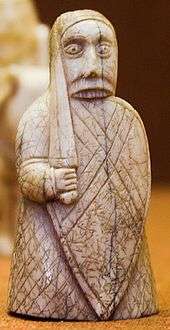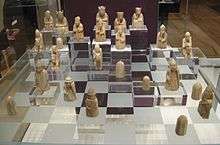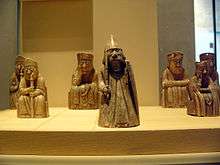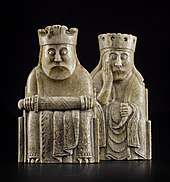Lewis chessmen
The Lewis chessmen (Norwegian: Lewisbrikkene; Scottish Gaelic: Fir-Tàilisg; Scots: Lewis chesmen) or Uig chessmen, named after the island or the bay where they were found,[1] are a group of distinctive 12th-century chess pieces, along with other game pieces, most of which are carved from walrus ivory. Discovered in 1831 on Lewis in the Outer Hebrides of Scotland,[2] they may constitute some of the few complete, surviving medieval chess sets, although it is not clear if a set as originally made can be assembled from the pieces. When found, the hoard contained 93 artifacts: 78 chess pieces, 14 tablemen and one belt buckle. Today, 82 pieces are owned and usually exhibited by the British Museum in London, and the remaining 11 are at the National Museum of Scotland in Edinburgh.
| Lewis chessmen | |
|---|---|
 Lewis chessmen in the British Museum | |
| Material | Walrus ivory and whales' teeth |
| Created | 12th century |
| Discovered | 1831 Uig, Lewis, Scotland |
| Present location | |
Additionally, a newly identified piece, a "warder", the equivalent of a castle or rook, was sold for £735,000 in July 2019. Four other major pieces, and many pawns, remain missing from the chess sets.[3]
Origin

Most accounts have said the pieces were found at Uig Bay (58°11′10″N 7°01′19″W) on the west coast of Lewis but Caldwell et al. of National Museums Scotland (NMS) consider that Mealista (58°06′14″N 7°06′29″W), also in the parish of Uig and some 6 miles (10 km) further south down the coast, is a more likely place for the hoard to have been discovered.[4]. The hoard was divided and sold in the 19th century – the British Museum (BM) holds eighty-two pieces and National Museums Scotland has the other eleven pieces.[5]
At the British Museum it was Sir Frederic Madden, Assistant Keeper of Manuscripts, who persuaded the Trustees to purchase for 80 guineas (£84) the eighty-two pieces which he had been misled into believing was the entire hoard. Madden was a palaeographer, a scholar of early vernacular literature, but he was especially intrigued by these artifacts because he was a chess enthusiast.[6][7] Madden immediately set about writing a monumental research paper about the collection, Madden (1832) – one that remains informative and impressive today.[8]
The British Museum claims the chessmen were probably made in Trondheim, the medieval capital of Norway, in the 12th century,[9] although some scholars have suggested other Nordic countries.[10] During that period, the Outer Hebrides, along with other major groups of Scottish islands, were ruled by Norway.[9]
According to Alex Woolf, director of the University of St Andrews Institute for Medieval Studies, there are reasons for believing the pieces came from Trondheim:
- A broken queen piece in a similar style was found in an excavation of the archbishop's palace – it appeared the piece was broken as it was being made.
- The presence of wealthy people in Trondheim able to pay craftsmen for high-quality chess pieces.
- Similar carving in Nidaros Cathedral in Trondheim.
- The excavation in Trondheim of a kite-shaped shield similar to shields on some of the pieces and a king piece of similar design found on Hitra Island, near the mouth of Trondheim Fjord. Woolf has said that the armour worn by the chess figures includes "perfect" reproductions of armour worn at the time in Norway.[11]
Icelanders Gudmundur Thorarinsson and Einar Einarsson have proposed that the chessmen originated in Iceland, since only in Iceland were the bishops called that at that time, while in other countries they used a name unassociated with the church,[12] they claimed. However, this was disputed by Woolf, who stated that the use of bishops originated in England,[11] and by Norwegian chess historian and member of Chess History & Literature Society, Morten Lilleøren.[13][14] The text that the Icelanders refer to[15] dates to the early 14th century, while two 13th century Latin texts from other countries call the chess piece bishop,[16][17] and the Lewis chessmen probably date to the 12th century. Moreover, there are many medieval chess bishops of various origins in different museums in Europe and USA.[18][19][20] A bishop that probably predates the Lewis chessmen was in the collection of Jean-Joseph Marquet de Vasselot and was sold at Christie's in Paris in 2011 with a radiocarbon dating report stating that there is a 95% probability that the ivory dates between AD 790 and AD 990.[21] It is thought to be English or German and carved in the 12th century. Stylistically it predates the Lewis chessmen, as its mitre is worn sideways[22][23] According to the lot essay with references, the presence of the bishop among the chess pieces was a twelfth century European invention. The bishop's inclusion reflects his status in the social system of the period, especially in Scandinavia and in England where clerics played significant roles in battlefield conflicts. The Icelanders further claim that the pieces were carved by an artist known as Margret the Adroit.[24][25][26]
Some historians believe that the Lewis chessmen were hidden (or lost) after some mishap occurred during their carriage from Norway to wealthy Norse towns on the east coast of Ireland, such as Dublin. The large number of pieces and their lack of wear may suggest that they were the stock of a trader or dealer.[9] Along with the chess pieces, there were 14 plain round tablemen for the game of tables and one belt buckle, all made of ivory, making a total of 93 artifacts.[27]
Description
Almost all of the pieces in the collection are carved from walrus ivory, with a few made instead from whale teeth. The 79[28] chess pieces consist of eight kings, eight queens, 16 bishops, 15 knights, 13 rooks (after the 2019 discovery) and 19 pawns. The heights of the pawns range from 3.5 to 5.8 cm, while the other pieces are between 7 and 10.2 cm. Although there are 19 pawns (a complete set requires 16), they have the greatest range of sizes of all the pieces, which has suggested that the 79 chess pieces might belong to at least five sets.[29] All the pieces are sculptures of human figures, with the exception of the pawns, which are smaller, geometric shapes. The knights are mounted on rather diminutive horses and are shown holding spears and shields. The rooks are standing soldiers or "warders" holding shields and swords; four of the rooks are shown as wild-eyed berserkers biting their shields with battle fury.[30] Some pieces bore traces of red stain when found, possibly indicating that red and white were used to distinguish the two sides, rather than the black and white used in modern chess.[11]

Scholars have observed that to the modern eye the figural pieces, with their bulging eyes and glum expressions, have a distinct comical character.[31][32] This is especially true of the single rook with a worried, sideways glance (front right of image below, next to queen) and the berserkers biting their shields, which have been called "irresistibly comic to a modern audience."[33] It is believed, however, that the comic or sad expressions were not intended or perceived as such by the makers, who instead saw strength, ferocity or, in the case of the queens who hold their heads with a hand and seemingly pensive expression, "contemplation, repose and possibly wisdom."[31]
Discovery
The chessmen were discovered in early 1831 in a sand bank at the head of Camas Uig on the west coast of the Isle of Lewis, in the Outer Hebrides of Scotland. There are various local stories concerning their arrival and modern discovery on Lewis.
Malcolm "Sprot" MacLeod (Scottish Gaelic: Calum an Sprot) from the nearby township of Pennydonald discovered the trove in a small stone kist in a dune, exhibited them briefly in his byre and sold them on to Captain Roderick Ryrie.[34] One reported detail, that it was a cow that actually unearthed the stash, is generally discounted in Uig as fabrication. After the Isle of Lewis was purchased by Sir James Matheson in 1844, Malcolm Macleod and his family were evicted and the district was transformed into sheep farms.
When the chessmen were uncovered in 1831, one knight and four warders were missing from the four sets.[35] In June 2019 a warder piece, which had previously gone unrecognised for at least 55 years, emerged in Edinburgh,[36][35] and was purchased at a Sotheby's auction for £735,000 the following month, by an undisclosed buyer.[37]
Exhibition and ownership
They were exhibited by Ryrie at a meeting of the Society of Antiquaries of Scotland, on 11 April 1831. The chessmen were soon after split up, with 10 being purchased by Charles Kirkpatrick Sharpe and the others (67 chessmen and 14 tablemen) purchased on behalf of the British Museum in London.
Kirkpatrick Sharpe later found another bishop to take his collection up to eleven, all of which were later sold to Lord Londesborough. In 1888, they were again sold, but this time the purchaser was the Society of Antiquaries of Scotland, who donated the pieces to the Royal Scottish Museum in Edinburgh. The eleven are now on display in the National Museum of Scotland.
Of the pieces given to the British Museum, most can be found in Room 40, with the registration numbers M&ME 1831, 11–1.78–159. Others have been lent to Scottish museums and temporary exhibitions.[9] A range of wooden or plastic replicas are popular items in the Museum shops.
The chessmen were number 5 in the list of British archaeological finds selected by experts at the British Museum for the 2003 BBC Television documentary Our Top Ten Treasures, presented by Adam Hart-Davis. They were featured in the 2010 BBC Radio 4 series A History of the World in 100 Objects as number 61, in the "Status Symbols" section.
An exhibition entitled "The Lewis Chessmen: Unmasked" included chess pieces from both the National Museum of Scotland and British Museum collections, along with other relevant objects, touring Scotland in 2010–2011. The exhibition opened in Edinburgh on 21 May 2010 and proceeded to Aberdeen, Shetland, and the Museum nan Eilean in Stornoway, opening there on 15 April 2011.[38]
An exhibition entitled "The Game of Kings: Medieval Ivory Chessmen from the Isle of Lewis" at The Cloisters in New York City included 34 of the chess pieces, all on loan from the British Museum. The exhibit ended on 22 April 2012.[39]
On 3 April 2013, £1.8 million from the European Regional Development Fund was granted to transform Lews Castle, on the Isle of Lewis, into a Museum for the Western Isles. Around £14 million in total is to be spent on restoring and converting the property, which has been shut for almost twenty-five years. When completed the permanent displays will include six of the Lewis Chessmen.[40]
Dispute over location

In 2007–2008 a dispute arose regarding the most appropriate place to display the pieces. The issue first arose[41] late in 2007 with calls from Scottish National Party (SNP) politicians in the Western Isles (notably Councillor Annie Macdonald, MSP Alasdair Allan and MP Angus MacNeil) for the return of the pieces to the place they were found. Linda Fabiani, the Scottish Minister for Europe, External Affairs and Culture, stated that "it is unacceptable that only 11 Lewis Chessmen rest at the National Museum of Scotland while the other 67 (as well as the 14 tablemen) remain in the British Museum in London."
Richard Oram, Professor of Medieval and Environmental History at the University of Stirling, agreed, arguing that there was no reason for there to be more than "a sample" of the collection in London. Both points of view have been dismissed by Margaret Hodge, the then UK Minister of State in the Department for Culture, Media and Sport, writing "It's a lot of nonsense, isn't it?"[34] The local historical society in Uig, Comann Eachdraidh Uig, which operates a registered museum near the find site featuring detailed information about the chessmen and Norse occupation in Lewis, has indicated publicly that it has no intention of pursuing any claim to the ownership of the pieces and does not support demands for them to be sent to Edinburgh, but would welcome short-term loans.[42]
In October 2009, 24 of the pieces from London and six from Edinburgh began a 16-month tour of various locations in Scotland. The tour was partly funded by the Scottish Government, and Mike Russell, the Minister for Culture and External Affairs, stated that the Government and the British Museum had "agreed to disagree" on their eventual fate. Bonnie Greer, the museum's deputy chairman, said that she "absolutely" believed the main collection should remain in London.[43]
 Selection of chessmen held at the National Museum of Scotland
Selection of chessmen held at the National Museum of Scotland King and Queen held at the National Museum of Scotland
King and Queen held at the National Museum of Scotland Two warders or rooks, held at the National Museum of Scotland
Two warders or rooks, held at the National Museum of Scotland A selection of some of the other pieces, with a row of bishops at the back and then knights.
A selection of some of the other pieces, with a row of bishops at the back and then knights. Knight on a stout horse (British Museum).
Knight on a stout horse (British Museum).- Back of a British Museum queen
 British Museum king and queen, with rook and knight behind them
British Museum king and queen, with rook and knight behind them
References
- "Uig Chessmen | Comann Eachdraidh Uig". Ceuig.co.uk. Retrieved 24 March 2017.
- "The enigma of the Lewis chessmen". Chessbase. 9 November 2010. Retrieved 15 August 2013.
- BBC news
- Caldwell et al, pp. 15–19.
- Caldwell et al, p. 11.
- Stratford, pp. 4–8, 10.
- Sotheby's, 2019
- Stratford, pp. 5, 8.
- "The Lewis Chessmen". British Museum. Retrieved 15 August 2013.
- Robinson, p. 14.
- McClain, Dylan Loeb (8 September 2010), Reopening History of Storied Norse Chessmen, New York Times, retrieved 14 September 2010 (appeared 9 September 2010 in the newspaper, page C2, New York Times)
- Are the Isle of Lewis chessmen Icelandic?, retrieved 14 September 2010
- Morten Lilleøren, "The Lewis Chessmen were never anywhere near Iceland". Chess History & Literature Society. Founded as Ken Whyld Association. Retrieved 28 February 2020.[https://www.kwabc.org/en/newsitem/some-comments-to-the-sothesby-catalogue-about-the-lewis-chessman-auctioned-in-july-2019.html?file=files/kwabc/news/2019/07/the_lewis_chessmen_were_never_anywhere_near_iceland_25-02-2012.pdf&cid=7233 ]
- Chess History & Literature Society.
- Mágus saga jarls
- Archaeologia, Or, Miscellaneous Tracts Relating to Antiquity, Volume 11
- Murray, H. J. R. (1913). A History of Chess, Oxford University Press. p.507 , p.521 p.530-533 .
- Gothic Ivories Project at The Courtauld Institute of Art, London, www.gothicivories.courtauld.ac.uk. Search on chess piece bishop 02 July 2019. 18 objects
- The Metropolitan Museum of Art. Chess Bishop probably made in Trondheim, Norway, AD 1150-1200. Retrieved 02 July 2019.
- The Historical Museum, Stockholm, Sweden. Chess bishop probably made in Norway or possibly England first part of 13th century. Retrieved 02 July 2019.
- Christie's SALE 1047 Oeuvres Médiévales provenant de la Collection Marquet de Vasselot Paris|16 November 2011. Retrieved 02 July 2019.
- Florida Center for Instructional Technology, College of Education, University of South Florida. Retrieved 02 July 2019.
- James Robinson, The Lewis Chessmen, The British Museum Press (2007), p.19
- Brown, Nancy Marie (2015). Ivory Vikings: the Mystery of the most Famous Chessmen in the World and the Woman who Made Them. New York: St. Martin's Press. ISBN 9781137279378.
- McClain, Dylan Loeb (8 September 2010). "Reopening History of Storied Ivory Chessmen". The New York Times. Retrieved 5 March 2016.
- "Bones of Contention". The Economist. 29 August 2015. Retrieved 5 March 2016.
- Robinson, pp. 5, 36, 54–55.
- After 2019 discovery
- Robinson, p. 30.
- Robinson, pp. 28–29.
- Robinson, pp. 37–41.
- N. Stratford, The Lewis chessmen and the enigma of the hoard (The British Museum Press, 1997), p. 48.
- Robinson, p. 37.
- Burnett, Allan (3 February 2008) "Stalemate". Glasgow. The Sunday Herald.
- "Long-lost Lewis Chessman found in Edinburgh family's drawer". BBC News. 3 June 2019. Retrieved 3 June 2019.
- "British Family Checks Their Drawers And Comes Out $1 Million Richer". The Daily Wire. 3 June 2019. Retrieved 3 June 2019.
- "Lost Lewis Chessman piece bought for £5 sells for £735,000 at auction". BBC. July 2019. Retrieved 2 July 2019.
- "Lewis Chessman exhibition opens in Stornoway museum". BBC. Retrieved 15 April 2011.
- "Ken Johnson, "Medieval Foes With Whimsey," New York Times, Nov. 18, 2011". Nytimes.com. 18 November 2011. Retrieved 15 August 2013.
- "New funding announced for Lews Castle Museum"
- "Moves to unite historic chessmen". 24 December 2007. Retrieved 5 December 2017.
- Uig News, February 2008
- Cornwell, Tim (2 October 2009). "Chessmen 'will never come home'". The Scotsman.
Sources
- Brown, Nancy Marie (2016), Ivory Vikings: The Mystery of the Most Famous Chessmen in the World and the Woman Who Made Them, St. Martin's Press, ISBN 978-1-250-10859-3
- Caldwell, David H.; Hall, Mark A.; Wilkinson, Caroline M. (2011). The Lewis Chessmen Unmasked. National Museums Scotland. ISBN 978-1-905267-46-0.
- Madden, Frederic (1832). "VII Historical Remarks on the introduction of the game of Chess into Europe, and on the ancient Chess-men discovered in the Isle of Lewis". Archaeologia, or, Miscellaneous tracts relating to antiquity. Society of Antiquaries of London. 24: 203–291 – via archive.org.
- Murray, H. J. R. (1985). A History of Chess. Oxford University Press.
- Robinson, James (2004), The Lewis Chessmen, British Museum Press
- Sotheby's (2019). "Attributed to The Lewis Chessmen Workshop, Probably Norwegian, Trondheim, 13th Century: a Warder". Sotheby's. Archived from the original on 30 November 2019. Retrieved 21 January 2020.
- Stratford, N. (1997). The Lewis chessmen and the enigma of the hoard. The British Museum Press.
- Taylor, Michael (1978). The Lewis Chessmen. British Museum Publications Limited.
External links

- The British Museum's page on the chessmen.
- National Museums Scotland's pages on the chessmen
- A History of the World in 100 Objects, Number 61: The Lewis Chessmen
- A Website dedicated to the Lewis chessmen, their form and history
- Sketchfab: 3D models of the chess pieces at National Museum of Scotland